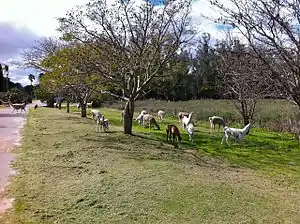Parque Lecocq
Parque Lecocq is a nature reserve[1] northwest of Montevideo, Uruguay, near the town of Santiago Vázquez. It houses mammals and birds[1] and protects flora[1] and pursues/supports breeding programs. It is adjacent to protected wetlands.[1]
 The entrance to Parque Lecocq, with several mammals roaming freely just outside the main gate | |
| Location | near Santiago Vázquez, Montevideo Department, Uruguay |
|---|---|
| Coordinates | 34.79180°S 56.33427°W |
| Land area | 120 hectares[1] |
| No. of animals | 500[1] |
| No. of species | 33[1] |
| Website | http://www.montevideo.gub.uy/ciudad/paseos/zoo-parque-lecocq |
Its mandate is to be a "support centre for biodiversity conservation both nationally and internationally."[1]
The zoo houses one of the largest communities of the Addax antelope (a critically endangered species) in the world.[2]
Ana Olivera, the mayor of Montevideo, has announced plans to move the animals of Zoo de Villa Dolores (located in central Montevideo) to Parque Lecocq by the end of 2015.[3]
History
The government of Montevideo's web site describes the history of Parque Lecocq as follows:
The land where the park is currently belonged to Don Francisco Lecocq (1790-1882), an outstanding man in Montevideo of his time. He was educated in England, where he forged a spirit of initiative and enterprise that applied in the importing country to its plants and animals return to their land, which still can be enjoyed in the park.
It originated in a project by architect Mario Paysée, whose goal was to create a place with animal species around the world in natural settings. It occupies an area of 120 hectares, bordering the protected area of St Lucia Wetlands.[1]
An arsonist set several fires at the park in early December 2008,[4] burning seven acres.[5] The park was temporarily closed as a result, reopening March 2009. No animals were injured, but habitat was damaged.[6][7]
Resident animals
The park houses the following animals:[8]
- capybara (carpinchos)
- antelope
- mouflon (muflones)
- fallow deer (ciervos dama)
- lion
- zebra
- emu
- ostrich (nandues)
- peccary (pecaries)
- chital (ciervos axis)
- colocolo (gato de pajonal)
- bobcat (gato montes)
- coati
- crab eating raccoon (mano pelada)
- coendou
- crab-eating fox (zorro de monte)
- gray fox (zorro gris)
- monkey (monos)
- llama
References
- Government of Montevideo. "Archived copy". Archived from the original on 2011-09-26. Retrieved 2017-03-19.CS1 maint: archived copy as title (link). Government of Montevideo. Retrieved 2011-09-09
- "Uruguay alberga una de las comunidades de antílopes más grande". El Pais. "Archived copy". Archived from the original on 2012-10-15. Retrieved 2017-03-19.CS1 maint: archived copy as title (link). Retrieved 2011-09-09.
- "Zoo de Villa Dolores al Parque Lecocq". El Pais. "Archived copy". Archived from the original on 2012-10-15. Retrieved 2017-03-19.CS1 maint: archived copy as title (link). Retrieved 2011-09-09.
- "Procesan a incendiario del Parque Lecocq." http://www.elpais.com.uy/08/12/10/pciuda_386482.asp. Retrieved 2011-09-09.
- "Parque Lecocq: cebras y leones casi al natural." http://www.elpais.com.uy/09/04/12/pciuda_410407.asp. Retrieved 2011-09-09.
- "El Parque Lecocq después del incendio." http://www.elpais.com.uy/Suple/QuePasa/09/05/23/quepasa_418538.asp. Retrieved 2011-09-09.
- "Bomberos extinguió incendios en Lecocq y Florida." http://www.elpais.com.uy/081208/ultmo-386092/ultimomomento/bomberos-extinguio-incendios-en-lecocq-y-florida/. Retrieved 2011-09-09.
- Government of Montevideo. http://www.montevideo.gub.uy/sites/default/files/articulo/mapa_0.pdf. Government of Montevideo. Retrieved 2011-09-09.